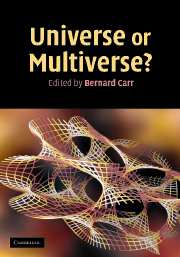Book contents
- Frontmatter
- Contents
- List of contributors
- Preface
- Acknowledgements
- Editorial note
- Part I Overviews
- Part II Cosmology and astrophysics
- 4 Cosmology and the multiverse
- 5 The anthropic principle revisited
- 6 Cosmology from the top down
- 7 The multiverse hierarchy
- 8 The inflationary multiverse
- 9 A model of anthropic reasoning: the dark to ordinary matter ratio
- 10 Anthropic predictions: the case of the cosmological constant
- 11 The definition and classification of universes
- 12 M/string theory and anthropic reasoning
- 13 The anthropic principle, dark energy and the LHC
- Part III Particle physics and quantum theory
- Part IV More general philosophical issues
- Index
- References
11 - The definition and classification of universes
Published online by Cambridge University Press: 05 July 2014
- Frontmatter
- Contents
- List of contributors
- Preface
- Acknowledgements
- Editorial note
- Part I Overviews
- Part II Cosmology and astrophysics
- 4 Cosmology and the multiverse
- 5 The anthropic principle revisited
- 6 Cosmology from the top down
- 7 The multiverse hierarchy
- 8 The inflationary multiverse
- 9 A model of anthropic reasoning: the dark to ordinary matter ratio
- 10 Anthropic predictions: the case of the cosmological constant
- 11 The definition and classification of universes
- 12 M/string theory and anthropic reasoning
- 13 The anthropic principle, dark energy and the LHC
- Part III Particle physics and quantum theory
- Part IV More general philosophical issues
- Index
- References
Summary
Introduction
When discussing the concept of multiple universes, it is a major challenge to keep the discourse within the bounds of science. There is an acute need to define what is being talked about. The issues include the following questions. How does one in general define a universe? Should one entertain different laws of physics in different universes? What are the most important parameters and/or features that characterize a universe? Once a parametrization has been attained, what is the differential probability of finding a universe with specified parameters? Is the integral of this distribution function finite or infinite?
A useful and familiar analogy is to consider planet Earth as a universe. It is, after all, not so long ago that this was mankind's paradigm. Then one may take the ensemble of universes, or multiverse, to be the set of all compact massive objects within the solar system which orbit the Sun and/or each other. Alternatively, one may take as a toy multiverse the set of all planets in the Galaxy or our universe. In either case, it is clear that the characterization of individual members of the ensemble is a very difficult task and requires a sophisticated understanding of much of planetary science, especially the experimental side of the subject.
One simplification of the general problem of classification is to restrict the consideration to that subset of universes (or — in the analogy — planets) which are nearly the same as our own. And this restriction can be naturally expressed in anthropic terms, by asking that the subset in question be that which admits in principle the existence of life as we know it. Even so, in the case of planets, this restricted problem is still very difficult. It is not clear whether our universe contains a large set of such planets, or whether the set only consists of our own planet. The problem is nicely described in the book Rare Earth by Brownlee and Ward [1].
- Type
- Chapter
- Information
- Universe or Multiverse? , pp. 181 - 190Publisher: Cambridge University PressPrint publication year: 2007



